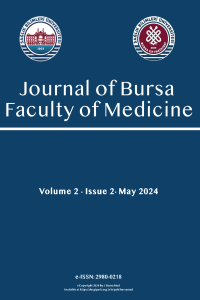A rare complication of high flow nasal cannula therapy in COVID-19: Caudal septal cartilage necrosis
Öz
A high-flow nasal cannula (HFNC) therapy has been frequently performed in adult patients with acute respiratory failure during the COVID-19 pandemic. With the increasing long-term use of HFNC, different complications have been observed. We aimed to share the nasal necrosis complication that occurred in our patient who had used HFNC for a long time.
Anahtar Kelimeler
high flow nasal cannula caudal septal cartilage necrosis intensive care unit complication
Kaynakça
- Perkins GD, Ji C, Connolly BA, et al. Effect of Noninvasive Respiratory Strategies on Intubation or Mortality Among Patients with Acute Hypoxemic Respiratory Failure and COVID-19: The RECOVERY-RS Randomized Clinical Trial. JAMA. 2022;327(6):546-558.
- Rochwerg B, Einav S, Chaudhuri D, et al. The role for high flow nasal cannula as a respiratory support strategy in adults: a clinical practice guideline. Intensive Care Med. 2020;46(12):2226-2237.
- Baudin F, Gagnon S, Crulli B, Proulx F, Jouvet P, Emeriaud G. Modalities and Complications Associated With the Use of High-Flow Nasal Cannula: Experience in a Pediatric ICU. Respir Care. 2016;61(10):1305-1310.
- Hegde S, Prodhan P. Serious air leak syndrome complicating high-flow nasal cannula therapy: a report of 3 cases. Pediatrics. 2013;131(3):e939-e944.
- Veiga VC, Silva LMCJ, Sady ÉRR, Maia IS, Cavalcanti AB. Epistaxis as a complication of high-flow nasal cannula therapy in adults. Epistaxe como complicação de tratamento com cânula nasal de alto fluxo em adultos. Rev Bras Ter Intensiva. 2022;33(4):640-643. Published 2022 Jan 24.
- Velasco Sanz TR, Sánchez de la Ventana AB. La oxigenoterapia de alto flujo con cánula nasal en pacientes críticos. Estudio prospectivo [High-flow nasal cannula oxygen therapy in critical patients. Prospective study]. Enferm Intensiva. 2014;25(4):131-136.
- Williams R, Rankin N, Smith T, Galler D, Seakins P. Relationship between the humidity and temperature of inspired gas and the function of the airway mucosa. Crit Care Med. 1996;24(11):1920-1929.
- Mauri T, Galazzi A, Binda F, et al. Impact of flow and temperature on patient comfort during respiratory support by high-flow nasal cannula. Crit Care. 2018;22(1):120.
- Kopelman AE, Holbert D. Use of oxygen cannulas in extremely low birthweight infants is associated with mucosal trauma and bleeding, and possibly with coagulase-negative staphylococcal sepsis. J Perinatol. 2003;23(2):94-97.
- Sivieri EM, Gerdes JS, Abbasi S. Effect of HFNC flow rate, cannula size, and nares diameter on generated airway pressures: an in vitro study. Pediatr Pulmonol. 2013;48(5):506-514.
- Hernández G, Roca O, Colinas L. High-flow nasal cannula support therapy: new insights and improving performance. Crit Care. 2017;21(1):62.
Öz
Kaynakça
- Perkins GD, Ji C, Connolly BA, et al. Effect of Noninvasive Respiratory Strategies on Intubation or Mortality Among Patients with Acute Hypoxemic Respiratory Failure and COVID-19: The RECOVERY-RS Randomized Clinical Trial. JAMA. 2022;327(6):546-558.
- Rochwerg B, Einav S, Chaudhuri D, et al. The role for high flow nasal cannula as a respiratory support strategy in adults: a clinical practice guideline. Intensive Care Med. 2020;46(12):2226-2237.
- Baudin F, Gagnon S, Crulli B, Proulx F, Jouvet P, Emeriaud G. Modalities and Complications Associated With the Use of High-Flow Nasal Cannula: Experience in a Pediatric ICU. Respir Care. 2016;61(10):1305-1310.
- Hegde S, Prodhan P. Serious air leak syndrome complicating high-flow nasal cannula therapy: a report of 3 cases. Pediatrics. 2013;131(3):e939-e944.
- Veiga VC, Silva LMCJ, Sady ÉRR, Maia IS, Cavalcanti AB. Epistaxis as a complication of high-flow nasal cannula therapy in adults. Epistaxe como complicação de tratamento com cânula nasal de alto fluxo em adultos. Rev Bras Ter Intensiva. 2022;33(4):640-643. Published 2022 Jan 24.
- Velasco Sanz TR, Sánchez de la Ventana AB. La oxigenoterapia de alto flujo con cánula nasal en pacientes críticos. Estudio prospectivo [High-flow nasal cannula oxygen therapy in critical patients. Prospective study]. Enferm Intensiva. 2014;25(4):131-136.
- Williams R, Rankin N, Smith T, Galler D, Seakins P. Relationship between the humidity and temperature of inspired gas and the function of the airway mucosa. Crit Care Med. 1996;24(11):1920-1929.
- Mauri T, Galazzi A, Binda F, et al. Impact of flow and temperature on patient comfort during respiratory support by high-flow nasal cannula. Crit Care. 2018;22(1):120.
- Kopelman AE, Holbert D. Use of oxygen cannulas in extremely low birthweight infants is associated with mucosal trauma and bleeding, and possibly with coagulase-negative staphylococcal sepsis. J Perinatol. 2003;23(2):94-97.
- Sivieri EM, Gerdes JS, Abbasi S. Effect of HFNC flow rate, cannula size, and nares diameter on generated airway pressures: an in vitro study. Pediatr Pulmonol. 2013;48(5):506-514.
- Hernández G, Roca O, Colinas L. High-flow nasal cannula support therapy: new insights and improving performance. Crit Care. 2017;21(1):62.
Ayrıntılar
| Birincil Dil | İngilizce |
|---|---|
| Konular | Yoğun Bakım |
| Bölüm | Case Reports |
| Yazarlar | |
| Yayımlanma Tarihi | 29 Mayıs 2024 |
| Gönderilme Tarihi | 20 Mart 2024 |
| Kabul Tarihi | 24 Nisan 2024 |
| Yayımlandığı Sayı | Yıl 2024 Cilt: 2 Sayı: 2 |



